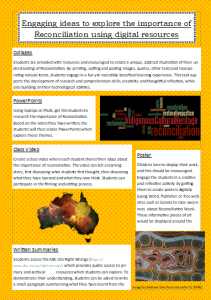7 Digital ideas for Reconciliation
Rebecca Trewick
This resource was created to address the issue regarding the lack of creativity in the current program that addresses the topic of Reconciliation. The question of whether there would be ways to incorporate both creativity and technology into the curriculum was raised, and whether the students could use their digital proficiencies to engage in learning activities. The document created for educators provides a multitude of flexible, innovative and practical tasks that involve students utilising a range of digital programs, resources and skills. While many of these activities have been written for easy application to the primary school levels, each task can be altered to suit the learning needs and capabilities of the students. The variety of activities allows the teacher to choose one which suits and can be completed in a reasonable timeframe.
While it has be argued that technologies have diminished the levels of creativity demonstrated by children, research has counteracted this statement, finding that programs, tools and apps can encourage collaboration, originality, inspiration and skill development (Gardner & Davis, 2013). Digital technologies have been used to support cultural understanding of Indigenous history in Australia and other countries. In Canada, digital storytelling by Indigenous youth “enabled non-Aboriginal viewers to better understand the perspectives and experiences of Indigenous youth” (Bissell & Korteweg, 2016). When addressing such a critical topic such as Reconciliation, it is important to use language and tools which the students can easily understand. Doing so provides students with a sense of ownership of their learning and makes the learning not only relevant and practical, but constructive and creative (Mackey-Smith, 2019). The aim of the activities included in the resource is to promote awareness and create a constructive learning environment where students can deepen their understanding of reconciliation.
The Early Years Learning Framework recognises that the Council of Australian Governments is “committed to closing the gap in educational achievement between Indigenous and non-Indigenous Australians within a decade” (DEEWR, 2009, p. 5). It also recognises that digital technologies are an important aspect of learning which help children achieve positive learning outcomes. Resources such as the one presented provide opportunities for educators to create learning environments that support learning of the critical topic of Reconciliation.
Links
Early Years Learning Framework (DEEWR, 2009)
- Outcome 4: Children are confident and involved learners
- 4.1 Children develop dispositions for learning such as curiosity, cooperation,
confidence, creativity, commitment, enthusiasm, persistence, imagination
and reflexivity
- 4.1 Children develop dispositions for learning such as curiosity, cooperation,
- Outcome 5: Children are effective communicators
- 5.5 Children use information and communication technologies to access information, investigate ideas and represent their thinking


